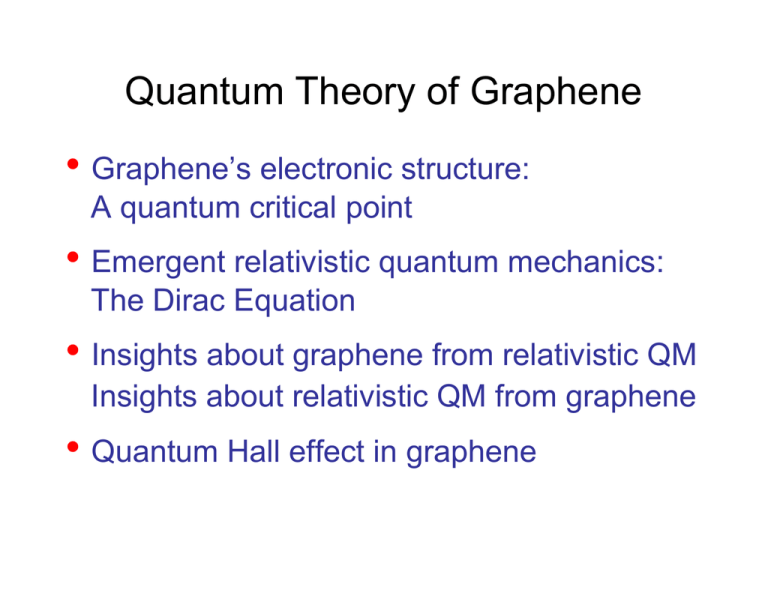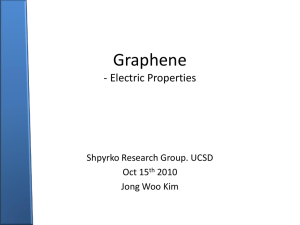Quantum Theory of Graphene
advertisement

Quantum Theory of Graphene • Graphene’s electronic structure: A quantum critical point • Emergent relativistic quantum mechanics: The Dirac Equation • Insights about graphene from relativistic QM Insights about relativistic QM from graphene • Quantum Hall effect in graphene Allotropes of elemental carbon 1.4 Å 3.4 Å Graphene = A single layer of graphite Graphene Electronic Structure Carbon: Z=6 ; 4 valence electrons 3s,3p,3d (18 states) sp2 bonding σ* 2s,2p (8 states) π σ 1s (2 states) π orbital (┴ to plane) derived from pz σ orbital (in plane) derived from s, px, py • σ bonds: exceptional structural rigidity • π electrons: allow conduction Hopping on the Honeycomb π Textbook QM problem: Tight binding model on the Honeycomb lattice sublattice A Just like CJ’s homework! sublattice B unit cell Benzene C6H6 Hopping on the Honeycomb π Textbook QM problem: Tight binding model on the Honeycomb lattice sublattice A Just like CJ’s homework! sublattice B unit cell Benzene C6H6 Hopping on the Honeycomb π Textbook QM problem: Tight binding model on the Honeycomb lattice sublattice A Just like CJ’s homework! sublattice B unit cell Benzene C6H6 Electronic Structure Metal • Partially filled band • Finite Density of States (DOS) at Fermi Energy Semiconductor • Filled Band • Gap at Fermi Energy Graphene A critical state • • Zero Gap Semiconductor Zero DOS metal Semiconductor Graphene 2 p Ec = Ec0 − * 2mc 2 p 0 Ev = Ev − * 2mv E = ±vF | p | “Fermi velocity” v F = 8 × 10 m / s 5 Theory of Relativity A stationary particle (p=0) has rest energy E = mc 2 A particle in motion is described by the relativistic dispersion relation: E = (mc ) + (cp) 2 2 Velocity: ∂E cp =c v= ∂p (mc 2 ) 2 + (cp ) 2 2 Albert Einstein 1879-1955 Massive Particle (e.g. electron) E = (mc 2 ) 2 + (cp) 2 Nonrelativistic limit (v<<c) 2 p E ≈ mc 2 + + ... 2m Massless Particle (e.g. photon) m=0 E =c| p| v=c Wave Equation ∂ E= ω ~i ∂t ; p = k ∼ −i ∇ (e.g. ψ = ei ( k i r −ωt ) ) Non relativistic particles: Schrodinger Equation p2 E= 2m 2 ∂ψ 2 ⇒ i =− ∇ψ 2m ∂t Relativistic particles: Klein Gordon Equation E 2 = c 2 p 2 + m2c 4 ⇒ 2 ∂ ψ 2 2 2 2 2 4 ( c m c )ψ − = − ∇ + 2 ∂t In order to preserve particle conservation, quantum theory requires a wave equation that is first order in time. Niels Bohr 1885-1958 Paul Dirac 1902-1984 Niels Bohr : “What are you working on Mr. Dirac?” Paul Dirac : “I’m trying to take the square root of something” Dirac’s Solution (1928) How can you take the square root of px2+py2+m2 without taking a square root? ⎛ m 1 0⎞ ⎜ ( px2 + p y2 + m 2 ) ⎛⎜ = ⎟ ⎝ 0 1 ⎠ ⎜ px + ip y ⎝ px − ip y ⎞ ⎛ m ⎟⎜ − m ⎠⎟ ⎝⎜ px + ip y px − ip y ⎞ ⎟ −m ⎠⎟ ( p + p + m ) I = pxσ x + p yσ y + mσ z 2 x 2 y “Dirac Matrices” : 2 ⎞ ; σ =⎛ σ x = ⎛⎜ ⎟ ⎜i y ⎝1 0⎠ ⎝ 0 1 0 −i ⎞ ⎛1 ; = σ ⎜0 z 0 ⎟⎠ ⎝ ⎤ ∂ψ ⎡ ⎛ ∂ ∂ ⎞ Dirac i = ⎢ −i ⎜ σ x + σ y ⎟ + σ z m ⎥ψ Equation ∂t ⎣ ⎝ ∂x ∂y ⎠ ⎦ 0⎞ −1⎟⎠ ⎛ψ A ⎞ ψ = ⎜ψ ⎟ ⎝ B⎠ Low Energy Electronic Structure of Graphene A B The low energy electronic states in graphene are described by the Dirac equation for particles with Mass : m=0 “Speed of light” c = vF ⎛ψ A ⎞ ψ = ⎜ψ ⎟ ⎝ B⎠ sublattice A sublattice B Emergent Dirac Fermions Consequences of Dirac Equation 1. The existence of Anti Particles E = ± (mc ) + (cp ) 2 2 anti electron = positron Massive Dirac Eq. ~ Semiconductor Gap 2 mec2 Effective Mass m*=me Anti Particles ~ Holes 2 Consequences of Dirac Equation 2. The existence of Spin • Electrons have intrinsic angular momentum J = L+S Sz = ± Total a.m. Orbital a.m. 2 Spin a.m. N • Electrons have permanent magnetic e- moment (responsible for magnetism) S • Interpretation natural for graphene ⎛ψ ↑ ⎞ ⎛ψ A ⎞ ⎜ψ ↓ ⎟ ∼ ⎜ψ B ⎟ ⎝ ⎠ ⎝ ⎠ “pseudo spin” ~ sublattice index Experiments on Graphene • Gate voltage controls charge n on graphene (parallel plate capacitor) • Ambipolar conduction: electrons or holes Landau levels for classical particles 4 3 2 1 1 eB En = (n + ) 2 m for n=0, 1, 2, .... Landau levels for relativistic particles 2 1 En = ± e v 2F Bn 0 1 2 for n=0, 1, 2, .... Existence of landau level at 0 is deeply related to spin in Dirac Eq.



